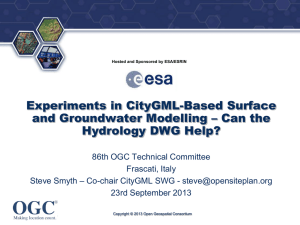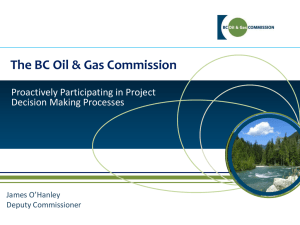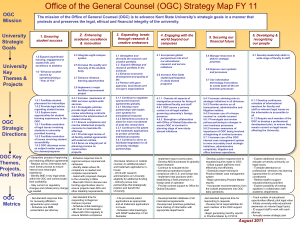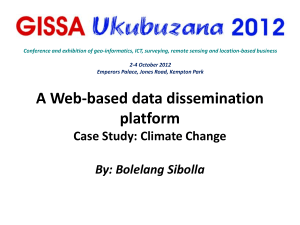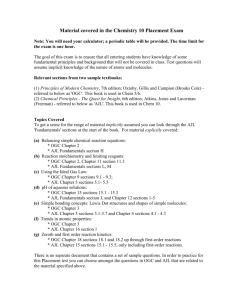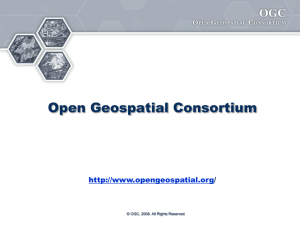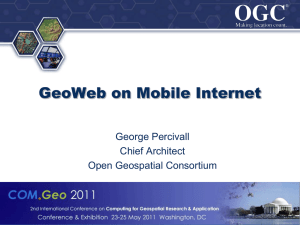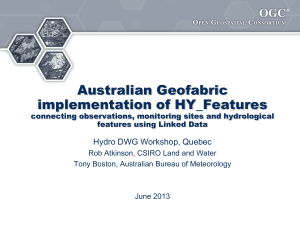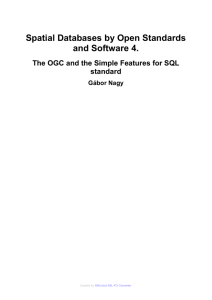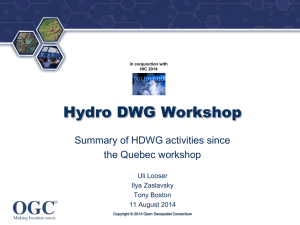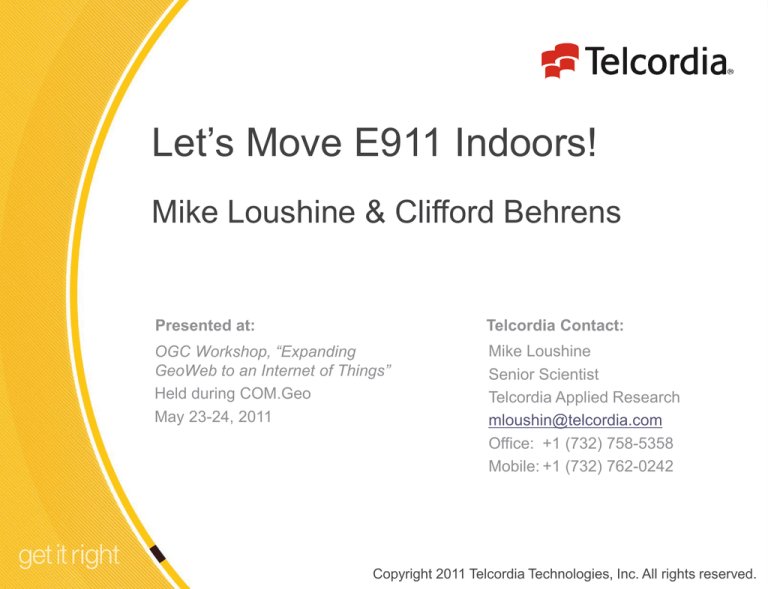
Let’s Move E911 Indoors!
Mike Loushine & Clifford Behrens
Presented at:
Telcordia Contact:
OGC Workshop, “Expanding
GeoWeb to an Internet of Things”
Held during COM.Geo
May 23-24, 2011
Mike Loushine
Senior Scientist
Telcordia Applied Research
mloushin@telcordia.com
Office: +1 (732) 758-5358
Mobile: +1 (732) 762-0242
TELCORDIA PROPRIETARY – INTERNAL USE ONLY
See proprietary restrictions on title page.
1
Copyright
2011 Telcordia Technologies, Inc. All rights reserved.
Outline
Where we are
2010 prototype of E911 services
How we got here
Implementation of mobile telecommunications standards
Implementation of localization and geospatial standards
Where we are going
Extend E911 scenario and prototype indoors
Implement other localization and geospatial standards required
to accomplish this
2
E911 Scenario Used for Prototyping
3
E911 Prototype (2010)
911 Caller
PSAP
UMDP Patrol Car
PGFD Fire Chief
HELD
LIS
WiMAX
Network
3G-GSM
Network
P-CSCF
E-CSCF
LRF
IMS Core
S-CSCF
I-CSCF
HSS
LOCSIP
Servers
Resource List
Server
Presence
Server
4
Location
Server
LOST
Server
Standards Used to Improve Situational
Awareness in E911 Prototype
3GPP IMS to
provide a SIP/IP core network
infrastructure
route 911 calls
IETF LoST to
GSMA RCS to
OMA LOCSIP to
convey terminal locations
OMA Presence SIMPLE to
OMA SUPL to
perform network-based position
determination of terminals
perform device-based position
determination of terminals
publish locations and presence
perform user-based position
determination of terminals
IETF HELD to
publish status and notifications
select the PSAP to answer 911
calls
perform network-based position
determination of terminals
WiMAX to
transmit and receive voice, video,
and other situational data
3G-GSM Networks to
5
transmit/receive situational data
perform network-based position
determination of terminals
Let’s Take E911 Indoors
Our technology demos have considered only outdoors
emergency scenarios
We now plan to extend the testbed by moving the
emergency scenario indoors
IETF PIDF-LO, OMA SUPL are existing standards that
are being extended to support indoor locations and
context.
Even richer context could be provided by OGC
CityGML.
6
Seamless Outdoors/Indoors
Contextualization
7
New Context and Requirements
Extensions to scenario
Fire within Chemistry Building
Need to provide indoor navigation support
to emergency responders
New Requirements
Indoor localization network
-
-
Seamless transition between world and local coordinate
systems
Accurate real-time positioning
Building Information Model (BIM) catalog
services
-
Feature-rich model of building interior
Content and access-descriptive metadata for BIM
Catalog service to help find BIM for a location
BIM data services (WFS)
-
Application to extract and return floorplan(s)
BIM LBS (WMS)
-
Contextualize indoor location with floorplan
Compute current location and routing information
More Standards
8
Indoor E911 Enablers –
Geospatial Standards
OGC
OGC 06-121r9, OGC® Web Services Common Implementation
OGC 07-006r1, OGC® Catalogue Service Implementation
OGC 06-042, OGC® Web Map Service (WMS) Implementation
OGC 09-025r1, OGC® Web Feature Service Interface Standard (also
ISO 19142)
OGC 08-007r1, OGC® City Geography Markup Language (CityGML)
Encoding
OGC 07-074, OGC® Location Service (OpenLS) Implementation:
Core Services
9
Indoor E911 Enablers –
Other Standards
IETF PIDF-LO
Provide Indoors Civic/Geodetic coding
Provide Relative Location
Georeference World CRS – Local CRS
GSMA RCS
Publish indoor/outdoor locations and presence
Perform user-based position determination of terminals, indoors and
outdoors
OMA Presence SIMPLE
Improve situational awareness through status publish and
notifications based on indoor extensions to PIDF-LO
OMA LOCSIP
Convey indoor and outdoor terminal locations
Make outdoors/indoors transition more seamless
10
Proposed Geospatial Enhancements to
E911 Prototype
1. 911 call made by CALLER
11
2. Select the PSAP to answer the call
3. PSAP makes request to Location
Service for CALLER location
4. PIDF-LO object for CALLER location
returned to PSAP
5. PSAP client queries OGC CS for
geospatial data objects whose
envelopes contain PIDF-LO location
6. OGC CS returns list of geospatial data
objects that contain CALLER‘s location,
e.g., maps, images, documents and
CityGML building models, along with
URIs/URLs for each.
7. PSAP application selects data objects of
interest, e.g., a CityGML building model,
and requests a floorplan map from an
OGC WMS.
8. OGC WMS requests floorplan features
from the OGC WFS that manages them.
9. OGC WFS returns floorplan features to
the OGC WMS.
10.OGC WMS builds floorplan map from
features and returns it to the PSAP
client.
11.PSAP client application (or another’s
application service) computes and
displays navigation route to CALLER
using responder’s current location and
floorplan.
Significance of E911 Prototyping Activities
to Geospatial Community
Demonstrate the value that standards offer to network
communications for managing emergencies
Provide feedback to standards forums based on
experiences from our demonstrations
Expose opportunities to enhance and integrate
standards in ways critical for meeting the needs of
decision-makers and emergency response teams
12


